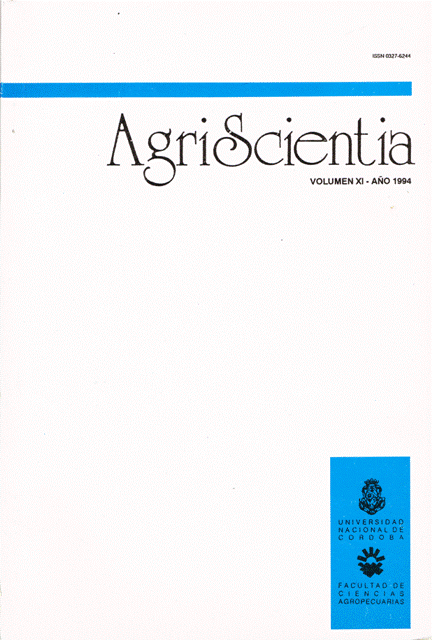Improvement of pisingallo maize (Zea mays L.) for the semi-arid region of Córdoba, Argentina. Dialelic analysis between pisingallo and colorado duro populations.
Main Article Content
Abstract
A partial diallel mating design was performed among four popcorn varieties: Paraná (P2), Anaranjado (P3), Amarillo (P4), and Colorado (P5), along with one adapted flint population of corn, MPB-FCA 856. Data was collected on the following characters: days to female flowering (DDF), ear length (LONG), grain yield (Rto.), and popping expansion (Exp.). Heterotic values were negative for several characters in relation to the best parent. DDF exhibited greater genetic diversity, with an epistatic effect that causes heterotic depression. The parental population showed a predominance of additive over dominance effects, allowing for population improvement schemes. Populations P2, P3, and P5 could be used to enhance popping expansion (Exp.), while P4 is a good popcorn parent and could be utilized to increase grain yield.
Article Details

This work is licensed under a Creative Commons Attribution-ShareAlike 4.0 International License.
How to Cite
References
Abdon Lira,M., 1986. Correlacoes fenotlpicas, genéticase de ambiente entre caracteresem Milho Pipoca (Zeamays L.).Ciencia e Práctica, Vol. 10, N2 1:11-18
Brunson, A.M., 1937. PopcornBreeding. Yearbook of Agri-culture:395-404.
Coscia, A., 1977.Maíces de poca difusión en Argentina ensu aspecto económico. Divulgación Técnica NO 29. E E-.RA. Pergamino.
Griffing,B., 1956. Concept of general and specific combi-ning ability in relation to diallel crossing systems Aus-tralian Journal Biological Science,9:463-493.
IBPGR, 1991. Descriptors for maize. International Maizeand Wheat Improvement Center, México City/Interna-tional Board for Plant Genetic Resources, Rome
López, C., J. Safont,M. Ferrer, G. Eyherabide y L. Solari,1993. Heterosis entre poblaciones élite de maíz colora-do cristalino y su incidencia en los procedimientos demejora. Jornadas sobre avances e investigaciones enmaíz, Facultad de Ingeniería y Ciencias Agrarias (Lo-mas de Zamora). pp. 21-25.
Mariotti, J., 1986. Fundamentos de la genéticabiométrica,aplicados al mejoramiento genético vegetal.OEA. Se-rie Biología, monografía N4 32. 152 pp.
Martinez Garza,A., 1989.Diseños y análisis de experimen-tos de cruzas dialélicos. Chapingo. México. Colegio dePost-graduados centro de Estadísticay cálculos. 252 pp
Moll, R.H., J.H. Lonnquist, J.V. Fortuna, and E.C. Johnson,1965. The relationship of heterosis and genetic diver-gonce in maice. Genetics 52: 139-144.
Reyes Castañeda, P., 1985. Métodos de Mejoramientopp. 202-215. In AGT editor S.A. Fitotecnia Básica yAplicada.
Sawazaky, E., P. Gallo, G. de Sordi, L. Longo, 1986 Estu-do da capacidade de expansao em cruzamentos dia-lelicos entre variedades de milho pipoca. EMBRA-PA/CNP - Milho e Sorgo, Area de Informacao, pp157-160.
Zinsly J.R., and J. Machado, 1987. Milho pipoca. In Pater-niani Ernesto y Viegas Glanco Pinto. led) Mclhoramen-to e producao de milho. Vol. 2. pp. 413-421.





